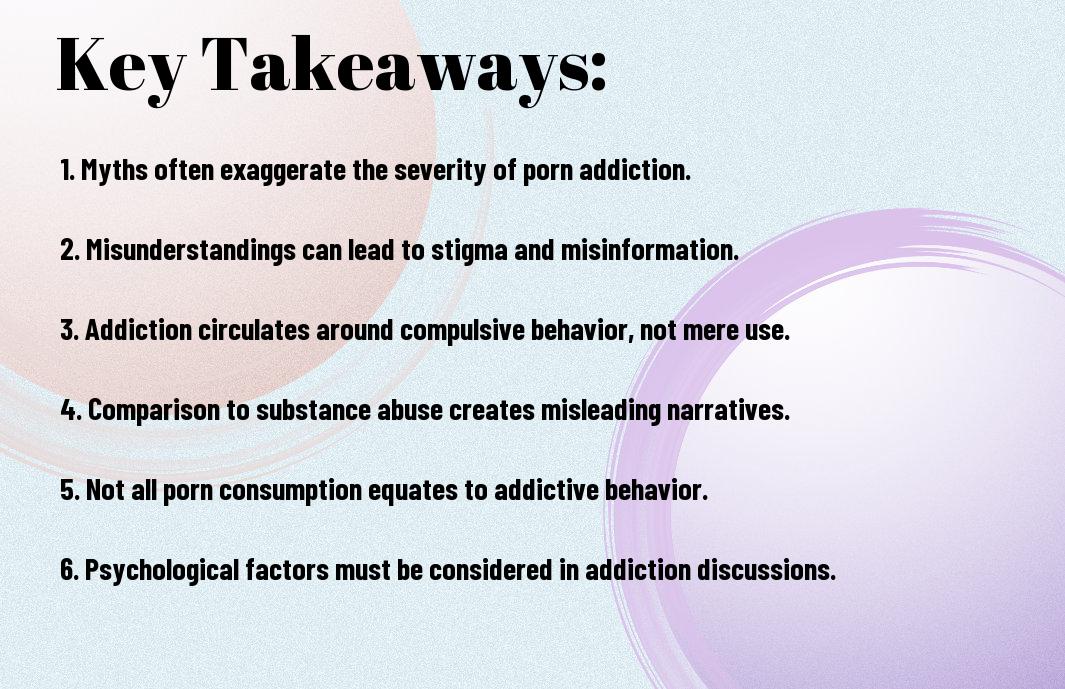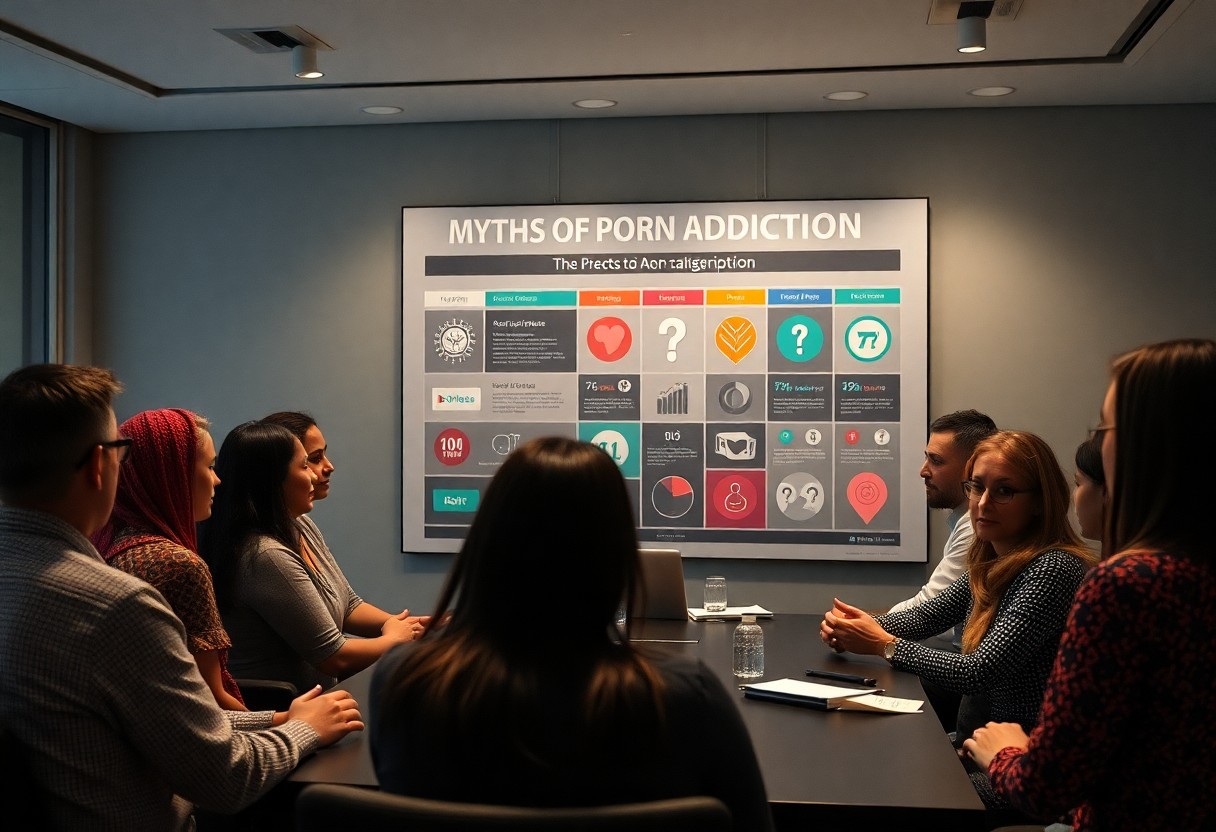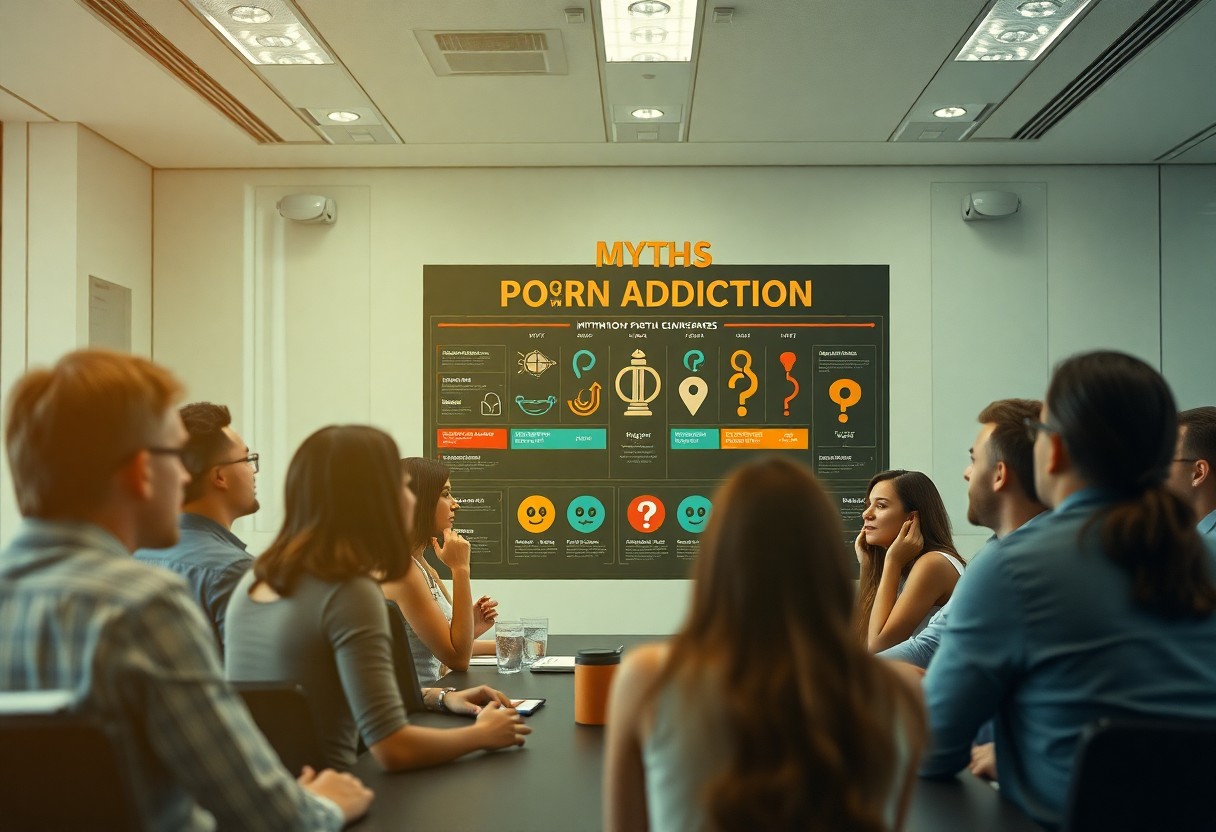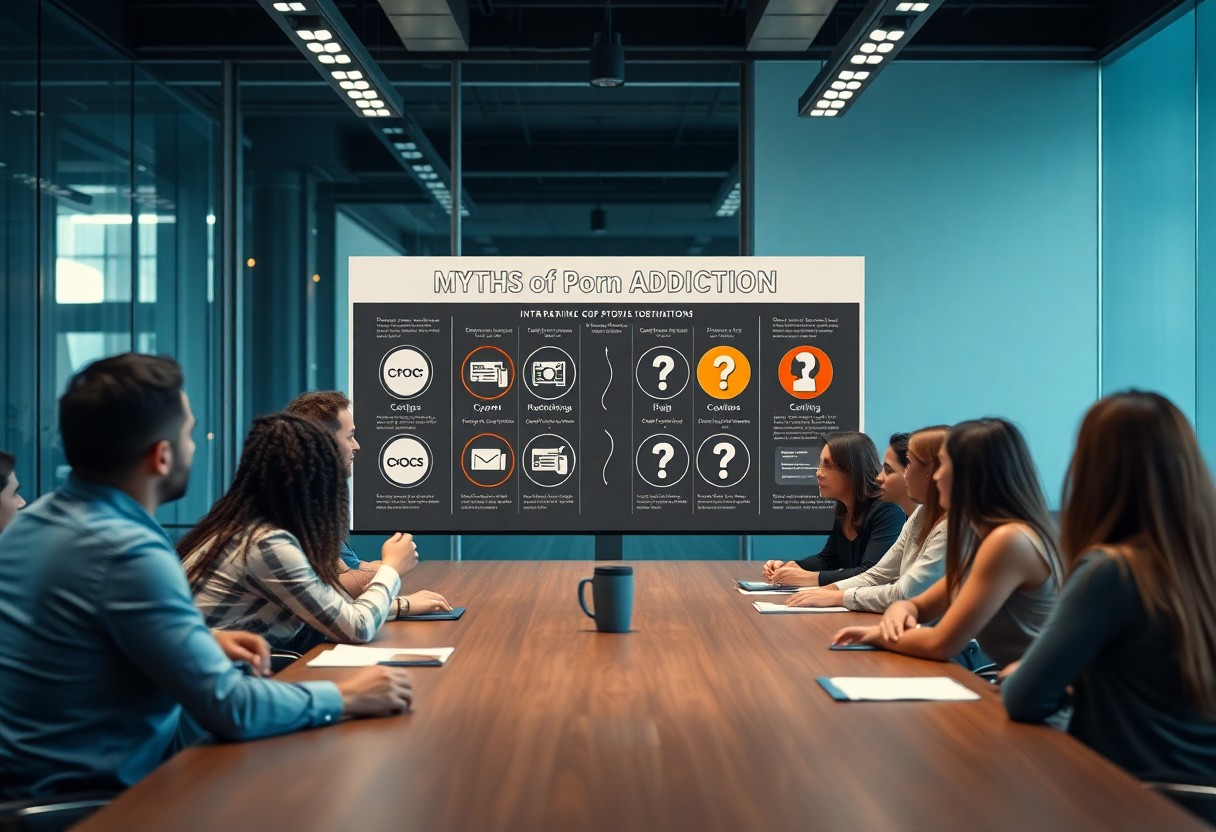There’s a pervasive misunderstanding surrounding porn addiction that can cloud your judgment. Many individuals fall prey to three prominent myths that distort the actual nature of this issue. Understanding these misconceptions is necessary for a more accurate perspective and a healthier approach to managing your relationship with adult content. For an in-depth exploration of this topic, check out The Myth of Porn Addiction: Science Says It’s a Habit.
Key Takeaways:
- Myth 1: Porn addiction is universally recognized as a mental health disorder, which it is not; it remains a controversial topic within the medical community.
- Myth 2: Engaging with porn always leads to addiction; however, many individuals can consume porn without detrimental consequences.
- Myth 3: There is a standard definition and set of symptoms for porn addiction, but the lack of consensus on what constitutes addiction complicates this issue.
- Mislabeling porn use as addiction oversimplifies complex issues related to mental health, relationships, and personal behavior.
- The media often sensationalizes porn addiction, contributing to stigma and misunderstanding of genuine sexual health concerns.
- Educational resources about healthy sexual behaviors can provide a more balanced perspective than focusing solely on negative consequences of porn consumption.
- Open dialogues about porn use and its effects are important for fostering understanding and addressing individual experiences without judgment.

Understanding Porn Addiction
While many people struggle to comprehend the complexities of porn addiction, it is necessary to acknowledge that this behavioral issue can significantly affect your mental health, relationships, and daily functioning. By recognizing the signs and understanding the underlying factors, you can take proactive steps toward addressing the problem and seeking appropriate help.
Definition and Symptoms
Beside the common misconceptions surrounding porn addiction, it is vital to define it clearly. Porn addiction involves compulsive consumption of pornography, leading to negative impacts on your life. Symptoms may include excessive time spent viewing porn, neglecting personal relationships, and experiencing distress when trying to cut back or quit.
Prevalence and Impact
With the rise of internet accessibility, the prevalence of porn addiction has become increasingly apparent. Many individuals, regardless of age or background, may find themselves struggling with this issue. The impact of porn addiction is profound, often leading to issues such as anxiety, depression, or sexual dysfunction.
In fact, research indicates that a significant portion of the population engages in problematic porn consumption, affecting not only individuals but also their loved ones. You might experience decreased intimacy in relationships and distorted views on sex that can perpetuate unhealthy behaviors. Understanding the prevalence and impact can help you navigate your experiences and seek necessary support for a healthier relationship with sexuality.

Myth 1: Porn Addiction is Just a Lack of Willpower
Even though many perceive porn addiction as a failure of willpower, it’s crucial to recognize that this issue is often far more complicated. Addiction can stem from deeper psychological factors, and simply exercising more self-control won’t address the underlying issues you may face.
Psychological Factors
Across various research findings, it’s evident that mental health conditions can contribute significantly to porn addiction. Various factors may include:
- Previous trauma or abuse
- Depression or anxiety disorders
- Low self-esteem issues
- Impulsivity or poor stress management skills
Thou must understand that addressing these psychological factors is key to overcoming addiction effectively.
Societal Misconceptions
Just as significant are the societal misconceptions surrounding porn addiction, often leading to stigmatization and misunderstanding. Many people equate addiction solely with moral failure, which oversimplifies the complexities involved.
In fact, societal beliefs can often deter you from seeking help, as the stigma may lead to feelings of shame. When society labels porn addiction as merely a lack of discipline, it ignores the nuanced interplay of psychological, environmental, and emotional factors that contribute to such behavior. Recognizing the complexity can help you make more informed choices regarding your mental health and well-being.

Myth 2: Only Heavy Users Can Be Addicts
Not all porn addicts fit the stereotype of heavy users. The misconception that addiction is only defined by frequent consumption overlooks the complexity of addiction itself. It is important to recognize that even moderate consumption can lead to addictive behavior, resulting in negative consequences in various aspects of your life. Your relationship with pornography may not be about the volume but rather the impact it has on your daily activities and mental health.
Spectrum of Consumption
Consumption of pornography exists on a spectrum. You might use porn occasionally without issues, but as your relationship with it becomes more compulsive, it may begin to affect your well-being or relationships. This variability emphasizes that addiction is not strictly about quantity; rather, it concerns your inability to control your use and the negative repercussions that follow.
Case Studies and Statistical Evidence
Case studies and statistical evidence reveal that porn addiction can affect individuals regardless of usage frequency. Examining various data highlights alarming trends:
- In a study by the University of Cambridge, 70% of participants who reported problematic use consumed porn less than five times a week.
- According to the National Center on Sexual Exploitation, 30% of individuals seeking help for addiction describe their consumption as “occasional” but still experience negative consequences.
- A survey from the Journal of Sex Research found that even infrequent users can experience symptoms similar to substance dependence, affecting their personal lives and mental health.
Hence, the definition of porn addiction extends beyond heavy usage. You might find that even sporadic use can lead to distortions in your perception of relationships, intimacy, and emotional well-being. Building awareness of your consumption patterns is imperative, regardless of how often you engage with pornography, as even occasional usage can escalate into problematic behavior.
Myth 3: Porn Addiction is Just a Phase
Now, many people believe that porn addiction is a temporary issue that one can simply outgrow. This myth downplays the seriousness of the addiction, suggesting that it won’t have lasting effects on your life. However, for many individuals, porn addiction can persist over time, becoming more entrenched and leading to significant emotional and relationship issues if left unaddressed.
Long-term Effects and Implications
Before dismissing porn addiction as a phase, it’s important to consider the long-term effects it can have on your mental health, relationships, and daily functioning. Prolonged engagement with porn can lead to unrealistic expectations in intimacy, emotional detachment, and even difficulties in forming or maintaining healthy relationships.
The Importance of Ongoing Support
For those grappling with porn addiction, having ongoing support is vital to your recovery journey. This support can come from friends, family, or professional counselors who understand the complexities of addiction and can help guide you through challenges.
This ongoing support allows you to cultivate strategies for managing triggers and emotional responses effectively. Surrounding yourself with a supportive community not only reinforces your commitment to recovery but also provides encouragement when facing setbacks. Whether through group therapy or personal connections, having people who understand your struggles can significantly enhance your healing process and help you develop healthier coping mechanisms.

The Role of Education and Awareness
Keep in mind that understanding porn addiction requires a comprehensive view of education and awareness. By equipping yourself with accurate information, you can better navigate the complexities surrounding this issue. Recognizing the factors contributing to unhealthy relationships with pornography is key to fostering a healthier dialogue in society.
Misconceptions in Media
Around you, the media often perpetuates myths about porn addiction, misrepresenting its implications and effects on individuals. These sensationalist portrayals can lead to stigma and confusion, hindering accurate understanding. You must critically evaluate the information presented and seek out reliable sources to form an informed perspective.
Promoting Healthy Discussions
Before engaging in discussions about porn addiction, it’s important to create a safe and open environment. This involves breaking down barriers to communication and ensuring that you and others can express concerns without fear of judgment. Encouraging dialogue fosters understanding and promotes healthier attitudes toward sexuality and personal well-being.
At the heart of promoting healthy discussions is recognizing the importance of empathy and support. By actively listening to different viewpoints, you can contribute to a more inclusive conversation. Sharing experiences and knowledge helps you and others navigate the complexities of porn addiction, reinforcing that it is a topic that can be addressed thoughtfully and collaboratively.
Treatment Options and Resources
Despite the misconceptions surrounding porn addiction, various treatment options and resources are available to help you regain control. You can explore materials like “Is Porn Addiction Real or Myth?” The Debate Continues to understand the challenges and solutions better. Keep in mind that the journey is unique to everyone, and seeking personalized guidance can significantly enhance your recovery experience.
Therapy and Support Groups
Treatment often includes therapy and support groups, which are valuable resources. Engaging with a professional can help you uncover underlying issues contributing to the addiction and develop coping mechanisms. Additionally, support groups provide a safe space to share experiences and connect with others facing similar challenges, enabling you to build a supportive network.
Self-Help Strategies
Strategies like setting personal goals, establishing healthy routines, and identifying triggers can aid your journey towards overcoming porn addiction. Utilizing journaling or mindfulness practices can enhance self-awareness, helping you manage cravings effectively.
Therapy may complement self-help strategies well by encouraging self-reflection and fostering personal growth. You might benefit from techniques like cognitive-behavioral therapy, which can help you recognize destructive patterns and replace them with healthier choices. Engaging in constructive activities, such as exercise or hobbies, can also fill your time and reduce the urge to engage in compulsive behaviors, leading to a more fulfilling lifestyle.
Final Words
Presently, understanding the myths surrounding porn addiction is important for your awareness and well-being. By recognizing that porn addiction can be misunderstood as a mere lack of willpower, overemphasis on dopamine, or a simple habit, you can approach the issue more objectively. This clarity allows you to separate fact from fiction, ultimately empowering you to make informed decisions about your relationship with adult content, addressing any concerns you may have in a more effective manner.
FAQ
Q: What are the common myths surrounding porn addiction?
A: There are several myths related to porn addiction, including the belief that it is the same as substance addiction, that all porn consumption is harmful, and that porn addiction only affects men. These misconceptions can distort our understanding of the complexity of sexual behavior and addiction.
Q: Why do people think porn addiction is the same as drug or alcohol addiction?
A: Many people confuse porn addiction with substance addictions because both involve compulsive behavior and can negatively impact individuals’ lives. However, the brain’s response to sexual stimuli is different from that of drugs or alcohol, making the nature of addiction distinct in this context. Additionally, unlike substance addiction, porn is often accessed in everyday life without the same environmental triggers, complicating the comparison.
Q: Is all porn consumption considered harmful and a sign of addiction?
A: Not all porn consumption is harmful. For many individuals, consuming porn can be a normal part of sexual expression. Issues arise when the consumption becomes compulsive to the point where it interferes with relationships, work, or daily functioning. Therefore, the context and frequency of usage are critical in assessing whether it signifies an addiction.
Q: How does the belief that porn addiction only affects men misrepresent the issue?
A: This belief misrepresents the vast spectrum of sexual behavior and its impact on all genders. Women also consume porn and can experience similar compulsive behavior or addiction. Research indicates that porn use among women is on the rise, and understanding addiction should encompass all genders to create an inclusive perspective about the issue.
Q: Can misconceptions about porn addiction lead to stigma and misunderstanding?
A: Yes, misconceptions can foster stigma, making individuals hesitant to seek help or discuss their experiences related to porn consumption. This stigma can create barriers to understanding healthy sexual behavior and can prevent individuals from addressing their concerns in a constructive manner.
